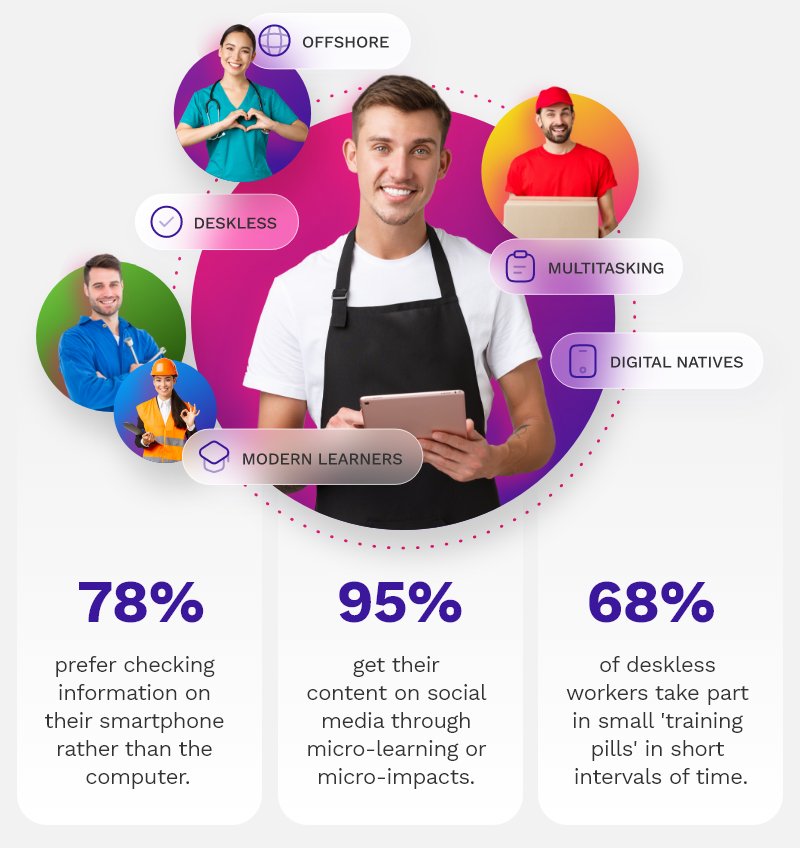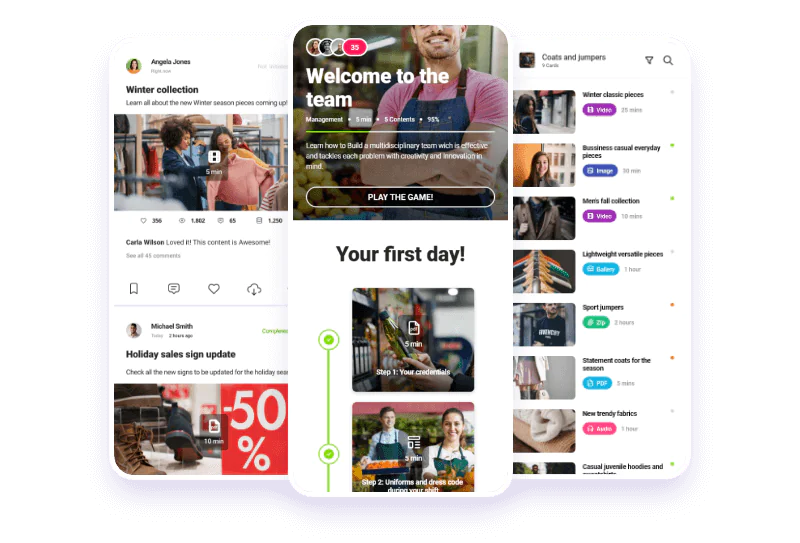Table of contents
ToggleThe frontline workers’ training market is growing fast, representing 80% of the global workforce, according to the report by Emergence: The rise of the deskless workforce. Nurses, sales reps, delivery drivers, point-of-sale staff, construction workers, drivers… These are just a few examples of the types of jobs that frontliners have.
Without a doubt, these types of workers are essential for any organization. Even though their role stands different from the rest of the company’s employees, you must offer them the same (or even more) development and training opportunities as the rest of your staff. But how can this be done effectively? Read on and find out!
What are frontline workers?
A frontline worker performs their duties in different locations, either in a fixed physical location (such as a hospital) or on the street. They are responsible for carrying out critical functions related to production, service or customer service. In essence, they form the backbone of a company, ensuring that all its daily activities run as smoothly as possible.
What roles exist in different industries?
Different types of frontline workers exist depending on the needs of each industry. In the field of medicine, for example, there are nurses and emergency personnel in addition to doctors. In the manufacturing sector, there are machine operators and floor workers, while, in the world of customer service, we find salespeople, shop assistants and even waiters. In all cases, their contribution is invaluable, since the performance of each directly impacts the quality of the final product or service.
Frontline workers in figures
As we’ve mentioned, the role of frontline workers is quite different from the rest of your staff. In addition to working outside the office (deskless workers), they have other characteristics and needs. Here are some numbers that will help you better understand these types of workers:
Growth of the frontline workers training market
Companies are increasingly aware of the importance of training their frontline professionals. In fact, according to one of the latest reports from Markets and Markets, the frontline workers training market will reach $40.1 million by 2027.
This growth is mainly due to the need to adapt corporate training programs to the characteristics of these workers using new formats and methodologies that improve their training experience.
Microlearning is the perfect match for frontliners due to its form of micro-content that they can complete on the go, right from their phones. But organizations must also invest in creating more dynamic and interactive e-learning content to keep them engaged and motivated.
Why it’s essential to adapt your internal communication strategy for your frontliners
Internal communication is fundamental to the proper functioning of any company. Without it, employees would not be updated on important news, policies that affect their daily work, and new products or services. They would have no way of knowing the organization’s values, mission, or strategy to which they belong.
Moreover, if we consider the new challenges the corporate sector faces, such as the recently named Great Resignation, organizations must find new ways to engage and retain talent. In fact, according to the Global Workforce Hopes and Fears study conducted by PwC in 2022, 1 in 5 workers changed companies within a year.
A correct internal communication strategy will be able to:
- Driving commitment
Employees will likely be more engaged with the organization if they work together toward a common goal. In addition, communication solutions that involve deskless workers sharing their opinions help them feel valued, which is also a significant driver of engagement.
- Increasing productivity
An effective communication strategy connects employees so they can solve problems quickly and work more efficiently. It also facilitates access to the documentation and resources needed to do their jobs properly.
- Reducing turnover
A survey conducted by Gallup revealed that those professionals who feel more engaged are between 24% and 59% less likely to change companies. Without a doubt, setting up specific communication solutions for deskless workers will benefit your company, as these are particular positions where turnover can represent a major problem.
Despite the benefits, only some organizations have a proper internal communication strategy, tailoring it to the specific needs of their employees. In fact, less than 60% of deskless workers are satisfied with their company’s communication solutions.
A well-elaborated communication plan will connect the company with its frontline workers no matter where they are, keep them aligned and committed to the organization’s objectives, and establish an agile communication channel that accompanies them in their day-to-day work.
Strategies to improve communication and collaboration between frontline workers
Many of the challenges frontline workers face relate to the fact that they work in a range of specific, physical environments that are often outside an office or headquarters. This not only makes communication more difficult, but can also affect real-time collaboration. In certain work environments, the lack of an effective platform for communication can result in disconnection between frontline workers and other teams within the organization, resulting in a negative impact on team cohesion and overall effectiveness. To improve collaboration and communication between frontline workers, it is crucial to implement specific strategies that address these challenges:
Gather everything they need in one place
Most organizations use various communication methods with their deskless employees: corporate email, bulletin boards, and unofficial communication channels such as WhatsApp groups. However, with these methods, you never know if the information is current or has been reviewed. With a corporate app, you can ensure that your data and documentation reach everyone in its latest version and keep track of who has consulted it.
Establish two-way communication channels
Improvement forms, surveys to know the opinion of frontliners, and systems to mark and evaluate documents will help them feel more valued and committed to the organization and to the information you make available to them, ensuring that it’s consulted.
Transversal communication
Traditionally, corporate communication was understood vertically: managers were in charge of elaborating the message they wanted to disseminate and sharing it with the rest.
Communication must now be cross-functional, especially when it comes to frontliners. They need to be in contact with their colleagues, even if they do not share a workspace. In this way, they can share tips and best practices based on their experiences, improving overall performance.
Don’t be afraid to make it fun
The best communication solutions for deskless workers are based on the social networks they use daily—concise, attractive, multimedia, and social content.
There are all kinds of dynamics that you can imitate: likes, comments, and sharing. How about awarding points for each content consulted? And preparing a quiz to find out your frontliners have assimilated the most critical information? You can achieve this thanks to corporate apps with social and collaborative dynamics.
Automatic notifications
How would you like to have an app with push notifications? These are especially useful when you need to send an urgent message to your entire organization and have guarantees that they have indeed received it.
Integrate communication technologies
Mobile devices are the tool of choice for these essential workers, so it makes sense to take advantage of them. This technology allows workers to utilize instant messaging apps, and access collaborative platforms that facilitate fast and efficient communication, irrespective of location.
Offer real-time collaboration platforms
Implement tools that enable real-time collaboration, such as video conferencing, to overcome geographical barriers and facilitate face-to-face communication – even when workers are in remote environments.
Implement task management systems
Implement practical systems that facilitate the assignment and tracking of tasks, to ensure more effective collaboration and foster a clear understanding of individual responsibilities.
Provide e-learning training tools
Training is one of the most important ingredients for the success of any company, but this is especially true when it comes to frontline workers, who face customer-related situations on a daily basis. Offering employees a dedicated space for continuous training within their workflow – one with interactive elements, micro content, infographics, images and tests – will not only improve their training experience, but also help them better retain knowledge and respond to different scenarios in their daily working life.
New technologies key to training your frontline workers
New technologies play a crucial role when training these professionals. All frontline workers rely on digital devices to carry out their daily tasks regardless of their position.
However, even as companies increasingly recognize the impact technology has on boosting productivity and job satisfaction for these workers, they still need to catch up when it comes to giving frontliners the technology they need to do their jobs well. Barely 1% of the $300 billion in annual funding of software companies goes towards specific solutions for these frontline workers.
If companies want to ensure long-term success, they need to provide their frontliners with digital tools that allow them to stay connected and up to date with everything happening in the organization. Frontline workers need access to all the latest corporate information and documentation in their workflow and manage their tasks seamlessly. But above all, they need practical and continuous training.
isEazy Engage, the training app for frontline workers
Today, the growth of new technologies and the rise of mobile devices have enabled the development of solutions to train frontliners, no matter where they are. The problem? Not all of them consider the specific needs of frontliners and transfer the training content to a mobile format. This means that frontline workers are disconnected from their training, with limited access and a lack of motivation.
With a training app like isEazy Engage, frontline workers will have training content suited to their needs. Companies can easily use microlearning strategies and create micro-content so that their workers can access their training through their smartphones and improve their learning experience. isEazy Engage allows you to add all kinds of interactive and multimedia content, such as videos, audio, exercises, and games, to the training and make learning much more dynamic.
isEazy Engage also provides access to communication, knowledge, and task management, all in one place. This way, you get a comprehensive solution designed for these professionals, increasing their engagement and productivity. What are you waiting for? Give it a try! Request a free trial of isEazy Engage and train and engage your frontliners with one integrated solution.















